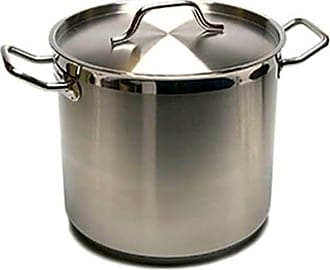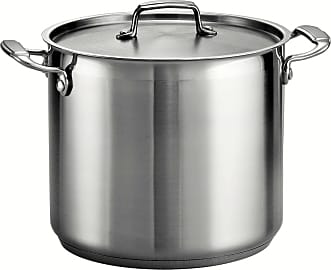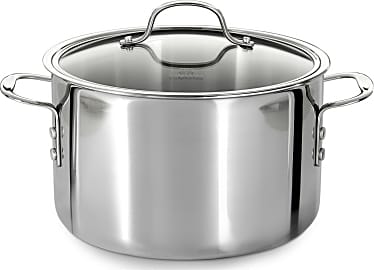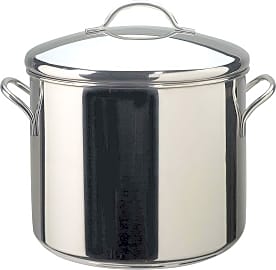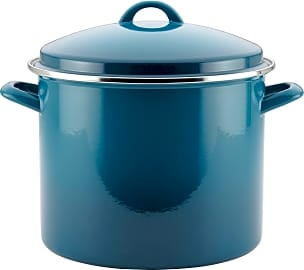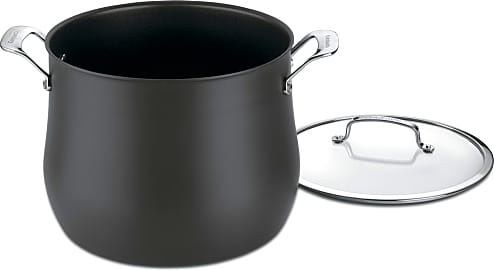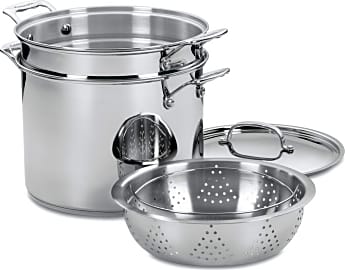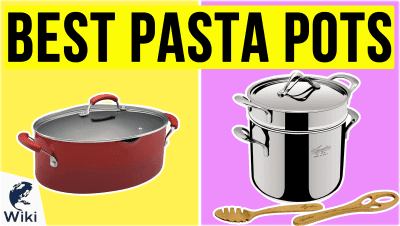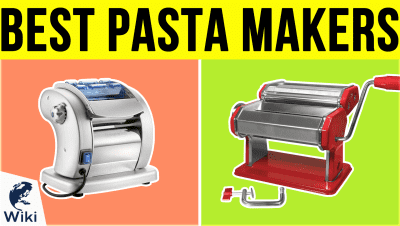The 10 Best Stockpots

This wiki has been updated 40 times since it was first published in June of 2015. Cooking for a family when you're busy is a lot easier if you can simply throw all the ingredients together and let them simmer until you're ready to eat. One of these stockpots will allow you to do just that, since they’ll provide a gateway into the culinary world of soups, stews, pastas, Cajun-style seafood boils, turkey brining, and more. Most of them are quite handsome, too. When users buy our independently chosen editorial recommendations, we may earn commissions to help fund the Wiki.
Editor's Notes
May 20, 2021:
We haven't changed any of our selections this time around, and in fact are extremely confident in our current recommendations. Like most of their products, the All-Clad 4506 is hard to beat, and it comes in 6- and 8-quart versions. The Onesource Pro Grade is a commercial-quality option, and the Tramontina Gourmet is on just about the same level although it's much more affordable. If you want to save even more money, that's totally possible; both the Rachael Ray 12-Quart and Cuisinart Chef's Classic are reasonably priced and built to last for years with proper care.
March 17, 2020:
Despite the attractive price of the Cook N Home Saucepot, we've opted to remove it, as its long-term durability may not be worth even its admittedly low cost. For those on a budget, there's the Granite Ware 15.5-Quart or the Rachael Ray 12-Quart. The latter is the smaller, but more robust, choice, one that comes in several handsome colors. These are fine for casual users, but for cooks who find themselves in the kitchen often, a longer lasting, more expensive version may be the way to go. That's why we've kept the popular All-Clad 4506 and the Tramontina Gourmet. These are attractive and highly usable thanks to their finishing touches, including incredibly sturdy handles, a tri-ply construction, and a lifetime warranty. They're also both appropriate for use with induction cooktops. The Farberware Classic, offered in 12 and 16 quart sizes, is a slightly more budget-friendly alternative, as is the Cuisinart Chef's Classic, a four-piece set that also doubles as an excellent pasta pot.
Special Honors
Hestan NanoBond Titanium The Hestan NanoBond Titanium is quite expensive, but it has all the thoughtful touches you could hope for, from a flared rim for easy pouring to flush rivets that make stacking it a breeze. Each is handcrafted in Italy, and can tolerate heat up to 1,050 degrees Fahrenheit — so it can handle just about anything you throw at it. hestanculinary.com
Ruffoni Historia With its hand-hammered copper and cast-brass pineapple finial, the Ruffoni Historia is so pretty, you may not want to put it to use. It's fairly small at 3.5 quarts, but it offers excellent simmering thanks to the belly shape that captures heat for consistent cooking. ruffoni.net
Vollrath Centurion This 38-quart model basically exudes premium build quality and long-term durability. It costs a pretty penny, but it's actually no stranger to high-end kitchens, as it's designed to last for a generation or more without cracking, warping, or significantly discoloring. vollrathfoodservice.com
Cooking: The Craft That Keeps On Giving
Everyone starts somewhere different; maybe your dad showed you how to fry an egg or your grandmother taught you her handcrafted, traditional recipes.
There's a practically endless body of knowledge regarding food and how it's prepared. Everyone starts somewhere different; maybe your dad showed you how to fry an egg or your grandmother taught you her handcrafted, traditional recipes. Some future cooks stood at their family's stove for hours after bedtime as a child experimenting with different spices and honing their palate. Wherever the roots, one thing's for sure: anyone can cook if they take the time and have the dedication to learn.
Many home cooks don't realize that there's one specific skill that underlies some of the basics of all cooking. In fact, at professional cooking schools, it's often among the very first techniques students learn. The creation of this basic ingredient involves a range of different methods, and once it's fully mastered, a budding cook is sure to know at least the foundations of modern cooking. That fundamental skill is the production of stock, one of the most important ingredients in many dishes.
Stock, at its simplest, is just flavored water. In practice, it's far more than that: it's an integral necessity that uses a nearly infinite variety of foods. Meats, fish, vegetables, herbs, seeds, nuts, and even fruits and cheeses can be used to add flavor to stock. Some of these flavors are simple, such as the classic mire poix of onion, carrot, and celery. Others, such as those from roasted beef bones, are so complex that scientists have yet to nail down the exact physiological effects of the chemicals that make them so delicious. Some flavors, such as apple or parmesan cheese, give stocks a unique purpose in special, exotic dishes. But why is this component so important? And how is it made?
Taking Stock of All The Flavors
On a basic level, stock is made by simply simmering your selected variety of foods in water for hours, and straining the result. Don't be fooled by this simplistic description, however. This important procedure really does employ some specific cooking methods that will help any cook perfect their skills and grow towards being a real chef.
The preparation of the ingredients in stock is of prime importance. Of course, when chopping any food, safe cutting practices are first and foremost on the list — as safety always should be. But once the bones are separated and the vegetables chopped, they are often also browned.
This increased viscosity enhances our ability to taste the subtle flavors that make a good broth so memorable.
To explain browning and why it matters, let's touch briefly on the concept of wet vs. dry heat. It's pretty straightforward: wet heat means cooking with water, dry heat means cooking without it. Steaming, boiling, and braising are examples of wet heat, and grilling, sauteing, and frying are examples of dry heat.
Two things happen when dry heat is applied to ingredients that will soon be simmered into stock. A lot of flavorful foods, especially seeds like cardamom, coriander, and fennel, contain powerfully tasty chemicals locked up in hydrophobic (non-water-soluble) cell walls, and those flavors might never make it into the stock if you don't pay them a little extra attention first. A light roasting unlocks these compounds, helping them to make it into your ultimate soup broth.
But the most important part of dry heat involves a combination of caramelization and the Maillard reaction. Anytime you experience food that's been browned, you're seeing, smelling, and tasting the results of these complex reactions between heat and either sugar or starch. Applying enough heat to brown bones, meat, vegetables, or seasonings causes the food's chemicals to react in unchartable ways and form chemical combinations that are so delicious we don't yet understand them. When those intricate flavors are dropped into boiling water, they dissolve over many hours to create the hearty, complex component known as stock in all of its meaty (and sometimes veggie) goodness.
Another immensely important chemical activity occurs during the near-sacred process of stock-making. Collagen, connective tissue present in almost all meat products and in very high concentrations in bones, is broken down very slowly over time into gelatin and incorporated into the liquid. This gives the stock body, making it ever-so-slightly thicker. This increased viscosity enhances our ability to taste the subtle flavors that make a good broth so memorable.
I Use Bouillon Cubes. Do I Still Need A Stockpot?
Short answer: absolutely.
Speaking of family gatherings, you surely can't simmer an entire cookout's worth of chili in a 4-quart saucepan.
Of course, stock isn't only an important part of the culinary world because someone's instructor made them learn it first. In truth, there is an entire world of complex sauces that are essentially predicated on having access to a high-quality batch of veal, beef, chicken, or seafood stock. Derived from the five classic mother sauces are dozens of intricate recipes, a majority of which will call for a well-made stock to thin them to the proper flavor and consistency. And today's finest restaurants use the glace de viande, which is just stock simmered until about 3/4 of the water has evaporated. But even if you prefer to skip the entire stockmaking process and buy pre-made soup base, you'll still find plenty of utility in having a stockpot.
Sometimes you'll need to boil a few pounds of pasta or blanch several handfuls of vegetables. The right pot can enable these tasks, letting you produce large batches of food. And what better place to wash and rinse a bunch of tomatoes or squash than a pot with a 2-5-gallon capacity? Even if you buy stock in a cardboard box (which can be delicious), you'll still need somewhere to cook up that soup for your whole family. Speaking of family gatherings, you surely can't simmer an entire cookout's worth of chili in a 4-quart saucepan.
So, pick up a good stockpot. Get one with the heaviest bottom you can find. And make sure you roast those bones before you drop them in the water.


